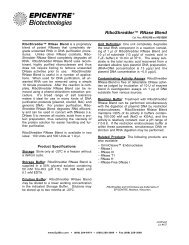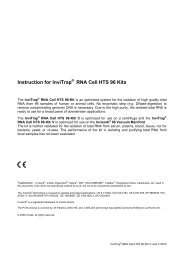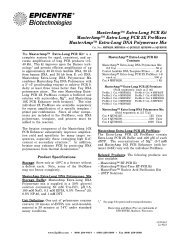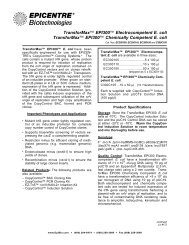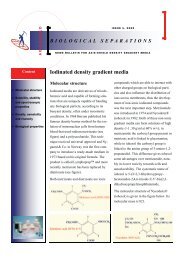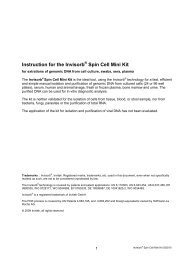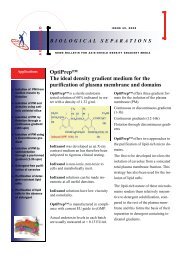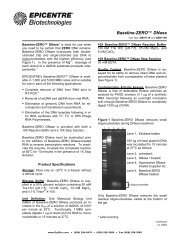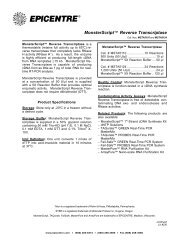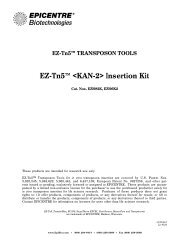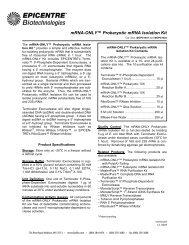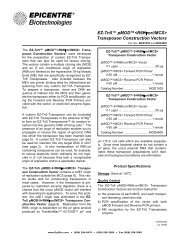Protocol for TransforMax™ EC100™ Electrocompetent E. coli
Protocol for TransforMax™ EC100™ Electrocompetent E. coli
Protocol for TransforMax™ EC100™ Electrocompetent E. coli
You also want an ePaper? Increase the reach of your titles
YUMPU automatically turns print PDFs into web optimized ePapers that Google loves.
Trans<strong>for</strong>Max EC100 <strong>Electrocompetent</strong> E. <strong>coli</strong><br />
Cat. Nos. EC10005 and EC10010<br />
Trans<strong>for</strong>Max EC100 <strong>Electrocompetent</strong><br />
E. <strong>coli</strong> are ideal <strong>for</strong> all cloning applications.<br />
Their higher efficiency, lack of size bias and other<br />
features make them ideal <strong>for</strong> trans<strong>for</strong>mation<br />
of EZ-Tn5 Transposon insertion clones or <strong>for</strong><br />
generating deletion libraries using the EZ::TN<br />
pWEB-TNC cosmid or pPDM plasmid deletion<br />
vectors. Since Trans<strong>for</strong>Max EC100 cells<br />
are restriction minus and lack trans<strong>for</strong>mation<br />
size bias against large inserts, they can be used<br />
to generate complete and unbiased primary<br />
bacterial artificial chromosome (BAC) libraries.<br />
Important Phenotypes and Applications<br />
• Ultra-high trans<strong>for</strong>mation efficiency (> 1 x 10 10<br />
cfu/µg of supercoiled DNA).<br />
• Compatible with vectors expressing the LacZ'<br />
α-complementing peptide <strong>for</strong> "blue / white"<br />
screening of recombinants.<br />
• Restriction minus <strong>for</strong> efficient cloning of methylated<br />
genomic DNA.<br />
• Accepts large clones <strong>for</strong> unbiased, primary<br />
cosmid and BAC clone library production.<br />
• Endonuclease minus (endA1) to ensure high<br />
yields of plasmid clones.<br />
• Recombination minus (recA1) to ensure the<br />
stability of large cloned inserts.<br />
Related Products: The following products are<br />
also available:<br />
− EZ-Tn5 Transposons<br />
− EZ-Tn5 Transposome Kits<br />
− Trans<strong>for</strong>Max EC100D pir+ and pir-116<br />
<strong>Electrocompetent</strong> E. <strong>coli</strong><br />
− Trans<strong>for</strong>Max EC100-T1 R <strong>Electrocompetent</strong><br />
E. <strong>coli</strong><br />
− Fast-Link DNA Ligation Kits<br />
Trans<strong>for</strong>Max EC100 <strong>Electrocompetent</strong><br />
E. <strong>coli</strong> are available in two sizes:<br />
EC10005 5 x 100 µl (10 Electroporations)<br />
EC10010 10 x 100 µl (20 Electroporations)<br />
Each is supplied with 10 µl (100 pg/µl) of<br />
pUC19 Control DNA in TE Buffer.<br />
Product Specifications<br />
Storage: Store Trans<strong>for</strong>Max EC100 E. <strong>coli</strong> cells<br />
at -70 o C and the pUC-19 Control DNA at either<br />
-20 o C or -70 o C.<br />
Genotype:<br />
F – mcrA ∆(mrr-hsdRMS-mcrBC) φ80dlacZ∆M15<br />
∆lacX74 recA1 endA1 araD139 ∆(ara, leu)7697<br />
galU galK λ – rpsL nupG.<br />
Quality Control: Trans<strong>for</strong>Max EC100 <strong>Electrocompetent</strong><br />
E. <strong>coli</strong> yield > 1 x 10 10<br />
trans<strong>for</strong>mants<br />
per microgram of supercoiled DNA. Trans<strong>for</strong>mation<br />
efficiency is determined using 10 pg of<br />
pUC19 control DNA, an Eppendorf Multiporator<br />
(2.5 kV, fast charge rate), and a 2 mm cuvette.<br />
Trans<strong>for</strong>Max EC100 <strong>Electrocompetent</strong> E. <strong>coli</strong><br />
are tested to be free of contaminating DNA rendering<br />
resistance to ampicillin, tetracycline, kanamycin<br />
and chloramphenicol.<br />
Trans<strong>for</strong>Max, EC100, EZ-Tn5, EZ::TN, EC100D, pPDM, pWEB-TNC, pWEB::TNC, Transposome and Fast-Link<br />
are trademarks of EPICENTRE, Madison, Wisconsin.<br />
−continued<br />
Lit. #147<br />
www.EpiBio.com • (800) 284-8474 • (608) 258-3080 • Fax (608) 258-3088
EPICENTRE<br />
Trans<strong>for</strong>Max EC100 <strong>Electrocompetent</strong> E. <strong>coli</strong><br />
Electroporation of Trans<strong>for</strong>Max EC100 <strong>Electrocompetent</strong> E <strong>coli</strong><br />
Note: The electroporation procedure described here uses 50 ml of electrocompetent cells. A different<br />
volume of cells can also be used based on the experiences and needs of the user.<br />
1. DNA should be in water or very low salt buffer (e.g. TE Buffer: 10 mM Tris-HCl [pH 7.5], 1 mM<br />
EDTA) to prevent arcing during electroporation. The pUC19 Control DNA is provided in TE at<br />
100 pg/ml. If running a trans<strong>for</strong>mation control, dilute the pUC19 Control DNA 1:10 (to a final concentration<br />
of 10 pg/ml) with sterile, deionized water and use 1 ml <strong>for</strong> electroporation.<br />
2. Prepare 1 ml of SOC or LB medium (do not include antibiotic in the medium) <strong>for</strong> each electroporation<br />
to be per<strong>for</strong>med. This medium will be used <strong>for</strong> post-electroporation outgrowth of trans<strong>for</strong>med<br />
cells. Maintain the medium at room temperature.<br />
3. Pre-chill electroporation cuvettes and 1.5 ml tubes on ice.<br />
4. Set-up the electroporation device according to the manufacturer's recommendations <strong>for</strong> bacterial<br />
(E. <strong>coli</strong>) electroporation.<br />
5. Thaw Trans<strong>for</strong>Max EC100 <strong>Electrocompetent</strong> E. <strong>coli</strong> cells on ice. Mix gently. Use the cells immediately.<br />
Unused cells can be refrozen at -70 o C. Note: Refrozen cells may have reduced trans<strong>for</strong>mation<br />
efficiency, but <strong>for</strong> most cases, the reduction is not significant enough to interfere with<br />
the desired results.<br />
6. Transfer the desired amount of DNA and 50 ml of cells to a pre-chilled microcentrifuge tube.<br />
Note: a smaller volume of cells can be used based on the needs and experiences of the user.<br />
Mix the cells and DNA by pipetting up and down 2-3 times.<br />
7. Transfer the cell/DNA mix to the electroporation cuvette. Be sure that there are no air bubbles in<br />
the cuvette. Wipe the cuvette of any condensation. Place into the electroporator and apply the<br />
electric pulse at the manufacturer's recommendations <strong>for</strong> bacterial (E. <strong>coli</strong>) electroporation.<br />
8. Immediately after electroporation, add 950 ml of room temperature SOC medium [Hanahan, D.,<br />
(1983) J. Mol. Biol., 166, 557] to the cuvette. Mix gently by pipetting up and down 2-3 times.<br />
9. Transfer the cells to a 15 ml tube and incubate at 37 o C with shaking at 220-230 rpm <strong>for</strong> 1 hour to<br />
recover the cells and allow expression of the antibiotic resistance marker.<br />
10. Dilute and plate the cells on appropriate medium and antibiotic. For cells trans<strong>for</strong>med with the<br />
control pUC19 DNA, plate on LB agar containing 100 mg/ml of ampicillin. The remaining cell outgrowth<br />
can be stored at 4 o C in the event additional cell dilutions are plated.<br />
Control (Optional): Dilute the control reaction 1:20 and plate 100 ml (equivalent to 0.05 pg DNA)<br />
to LB-ampicillin (100 mg/ml) plates. If 250 colonies are observed on the plate, the trans<strong>for</strong>mation<br />
efficiency is 5 x 10 9 cfu/ mg or [(250 cfu/0.05 pg DNA) x (10 6 pg/mg)].<br />
page 2 8/06




